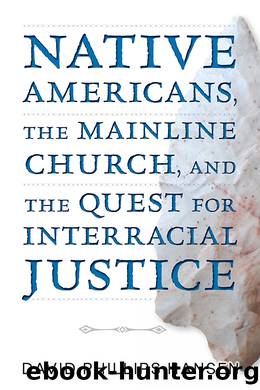Native Americans, The Mainline Church, and the Quest for Interracial Justice by Hansen David Phillips;

Author:Hansen, David Phillips;
Language: eng
Format: epub
Publisher: Chalice Press
Defining Our Identity Story
The late Marcus Borg, an influential religious scholar and interpreter of scripture in the mainline church, calls the Exodus Israelâs âstory of sacred origins.â¦It not only told the story of Israelâs creation but shaped the world in which she lived.â5 Memory of the Exodus continues to shape Jewish identity. This story of the flight to freedom is retold annually in the celebration of Passover during which Jews remember the events surrounding the journey to freedom and claim this ancient story as their own. Many mainline Christian congregations enact a symbolic Seder meal during the Christian holy season of Lent. Participating congregations recount Israelâs dramatic flight to freedom as they eat bitter herbs and other foods, and in so doing make Israelâs birth story part of their own narrative.
Borg identifies the Exodus as Israelâs âprimal narrative,â by âprimalâ meaning that it is Israelâs most important story, its story of origins, and its archetypal story, the story that ânarrates the perennial struggle between the world of empire and the liberating will of God, between the lordship of Pharaoh and the lordship of God.â6 He points out that the exodus is fundamentally a story of promise and fulfillment that has two main parts: conquest of the land of Canaan and the promise of a multitude of generations. The third part is a series of specific threats to the promise.
The drama begins to unfold when God promises Abraham and Sarah: âGo from your country and your kindred and your fatherâs house to the land that I will show you. And I will make you a great nationâ (Gen. 12:1â2a). We soon learn that Israelâs matriarchsâSarah, Rebekah, and Rachelâare barren women whose inability to bear children puts the future of Israel at risk. Although there is no virgin birth in these stories, time and again God faithfully intervenes to keep alive the promise of a multitude of generations.
A new threat to the promise looms when the sons of Jacob (the grandson of Abraham and the son of Isaac) sell their brother Joseph to human traffickers who take him to Egypt. After numerous trials, Joseph establishes himself in a key post in the pharaohâs government. When famine in the land of Israel drives Josephâs brothers to Egypt in hopes of finding food, Joseph is there to welcome them. The brothersâ betrayal is turned into a life-saving blessing.
The Hebrew people settle in Egypt and prosper. Their population grows. The pharaoh sees what is happening and becomes concerned that the Hebrews are too numerous. In order to control them, he enslaves them. Through this long series of events, the pattern of promise-threat-fulfillment is firmly established, and we are ready for Israelâs flight to freedom, which Marcus Borg identifies as âa paradigmatic story of Godâs character and will,â and âIsraelâs decisive and constitutive âidentity story,ââ7 which unfolds in four episodes: (1) deliverance, (2) rebellion, (3) subjugation, and (4) conquest of the Promised Land.
Deliverance
The story of Israelâs deliverance begins with groans of hope rising from the lips of oppressed Hebrew slaves.
Download
This site does not store any files on its server. We only index and link to content provided by other sites. Please contact the content providers to delete copyright contents if any and email us, we'll remove relevant links or contents immediately.
The Lost Art of Listening by Michael P. Nichols(7409)
Why I Am Not A Calvinist by Dr. Peter S. Ruckman(4103)
The Rosicrucians by Christopher McIntosh(3467)
Wicca: a guide for the solitary practitioner by Scott Cunningham(3127)
Signature in the Cell: DNA and the Evidence for Intelligent Design by Stephen C. Meyer(3071)
Real Sex by Lauren F. Winner(2968)
The Holy Spirit by Billy Graham(2893)
To Light a Sacred Flame by Silver RavenWolf(2768)
The End of Faith by Sam Harris(2691)
The Gnostic Gospels by Pagels Elaine(2472)
Waking Up by Sam Harris(2392)
Nine Parts of Desire by Geraldine Brooks(2326)
Jesus by Paul Johnson(2310)
Devil, The by Almond Philip C(2282)
The God delusion by Richard Dawkins(2265)
Heavens on Earth by Michael Shermer(2237)
Kundalini by Gopi Krishna(2137)
Chosen by God by R. C. Sproul(2123)
The Nature of Consciousness by Rupert Spira(2047)
